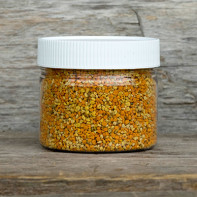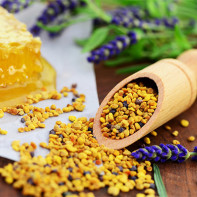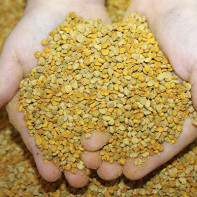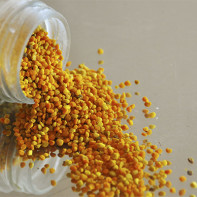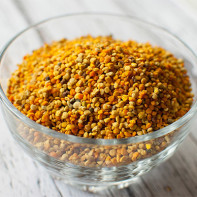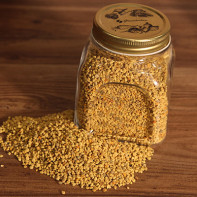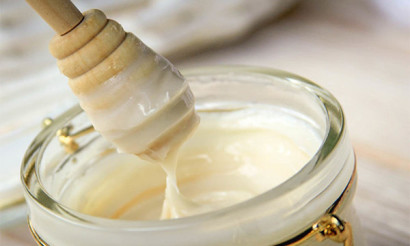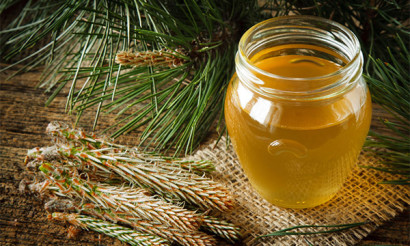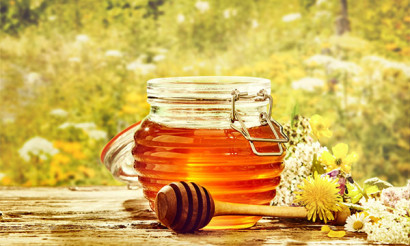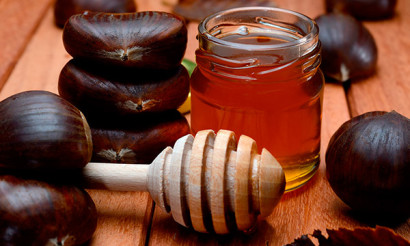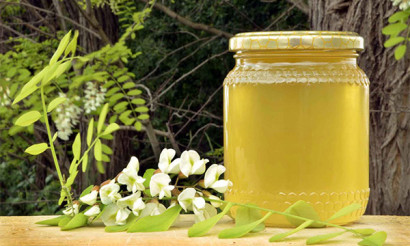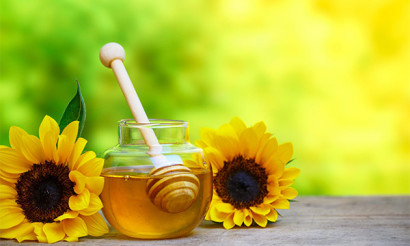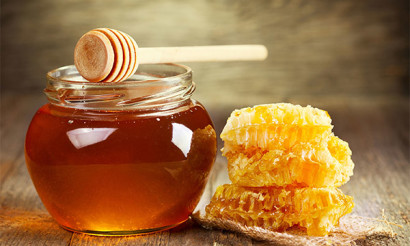Bee pollen: useful properties and contraindications
Bee pollen is one of the most nutritious foods in the world. An interesting fact is that the protein content is so high that 2 spoonfuls of pollen are comparable with pork steak in the amount of protein. It has a pleasant taste (sweet) and is versatile in its use, so its consumption quickly becomes a habit.
- What is bee pollen
- What is the difference between bee pollen and bee pollen
- How to gather bee pollen
- Composition and caloric content
- Bee pollen useful properties
- General benefits
- For women
- For Men
- For Pregnancy
- For children
- What is bee pollen useful for weight loss
- Therapeutic properties of bee pollen
- Bee pollen in cosmetology
- How to use bee pollen
- Harms and contraindications
- How to store bee pollen
After 7-10 days after starting to use pollen you can feel a significant burst of energy. Taking pollen, you can reduce the amount of regular food, because it is very nutritious and also helps to suppress appetite. But, despite its usefulness, it is not recommended to consume this product in large quantities, because there is a risk of allergic reactions.
What is bee pollen
Bee pollen is a product produced by bees as a result of collecting and processing pollen particles from honey plants, the food they feed on. The insects collect the pollen particles and then process them into small balls.

Pollen balls of different colors are similar in appearance to buckwheat grits. Their color can vary from yellow to purple, and the smell of the peas is honey-floral. They are practically tasteless, and can be quite easily flattened by applying a little pressure with your fingers.
What is the difference between bee pollen and bee pollen
Both pollen and bee pollen are products that are directly related to the activity of bees and the process of processing plant pollen. Pollen is collected from plants and carried into the hive. In order not to lose the collected pollen on the way, the insect wets it with its saliva, which results in small yellow peas. Pollen pellets are highly hygroscopic (able to absorb moisture) and cannot be stored for long. Therefore, bees "preserve" pollen with saliva and honey by clogging these pellets with a film of wax. After the blockage, fermentation begins. After 3 weeks, a new substance is produced which is called percha.
The products can be distinguished by their appearance. Pollen is in the form of small yellowish-brown grains, which have a pleasant floral and honey aroma. Beebreadth is a brownish pellets of larger size with a denser consistency. Perga is similar in odor to the aroma of bee nectar. The products also differ in their nutrient content. Pollen, sometimes called "obnozhka", consists of 24% protein, 3% fat, 18.5% sugars, 2.55% minerals and 0.56% lactic acid. Beebreadth contains 20-21% proteins, 0.6-1.5% fats, 24-34% sugars, 2.4-2.6% minerals and 3% lactic acid. It is also worth noting that the featherbed has a longer shelf life in contrast to pollen grains.
How to collect bee pollen
As a rule, the collection of bee pollen begins in mid-spring. During this period, bees are actively engaged in collecting forage, storing it in their honeycombs and sealing it with wax. The beekeeper needs to "take away" some of the pollen from the insects before they can get it into the hive. To do this, there are special devices called pollen catchers. Over the season, a single bee family can collect about 50 kg of pollen grains. It is worth noting that the bees need only half of the collected pollen for their vital activity, so the insects do not suffer much from the "selection" procedure.
A pollen catcher is a box with lattices in the form of a tray. The front grid is needed to trap pollen grains. The second is a filter that prevents the collection of debris. After 4-5 days, the right amount of pollen is collected in the boxes. As a rule, the raw material is collected at night, so as not to disturb the bees.
Composition and calories
Pollen is a fairly nutritious product, rich in biologically active substances. Pollen grains contain about 200 different substances. The group of major chemical constituents includes proteins, amino acids, carbohydrates, lipids and fatty acids, phenolic compounds, enzymes and coenzymes, as well as vitamins and bioelements.
Pollen consists of 24% protein and 10.4% amino acids such as methionine, lysine, threonine, histidine, leucine, isoleucine, valine, phenylalanine and tryptophan. These elements are vital for the human body, but it cannot synthesize them on its own. In addition, pollen contains a significant amount of nucleic acids, especially ribonucleic acids.
Pollen also contains lipids (5.1%). Acids such as linoleic acid, gamma linoleic acid, and arachidonic acid account for 0.4%. Phospholipids are 1.5%, while phytosterols, P-sitosterol, are present in an amount of 1.1%.
Phenolic compounds average 1.6%. This group includes flavonoids, leukotrienes and catechins. Among flavonoids (1.4%) found in pollen, there are mainly kaempferol, quercetin and isoramnetin, and in the group of phenolic acids (0.2%) - mainly chlorogenic acid.
Pollen is a source of fat-soluble vitamins (0.1%) such as provitamin A and vitamins E, D and water-soluble (0.6%) such as B1, B2, B6 and C, as well as acids: pantothenic, nicotinic and folic, biotin, rutin and inositol.
The pollen also contains bio-nutrients: calcium, phosphorus, magnesium, sodium and potassium, as well as trace elements: iron, copper, zinc, manganese, silicon and selenium.
Useful properties of bee pollen

General benefits.
- Rich in antioxidants. Bee pollen is a source of antioxidants: glutathione, quercetin, carotenoids and flavonoids. Antioxidants help the body fight inflammation as well as free radical damage. If the body does not have protection against such damage, it is prone to oxidative damage in cells and tissues, which can lead to chronic disease, autoimmune disorders, cancer and type 2 diabetes.
- Strengthens the natural immune system. Consumption of pollen helps strengthen the natural immune system, which helps prevent and reduce the severity of colds, flu-like illnesses and other viral infections. This product is also antimicrobial and can help fight bacterial infections as well as dangerous bacteria such as E. coli, Staphylococcus and Salmonella.
- Benefits during menopause. Menopause is quite debilitating for women. During this period, unpleasant symptoms such as hot flashes, headaches, excessive sweating, mood disorders and insomnia appear. Research shows that bee pollen can help alleviate some of the symptoms of menopause, especially hot flashes, joint pain, and its consumption can also have a beneficial effect on mood, energy levels and sleep quality.
- Controls cholesterol balance. Excessively elevated cholesterol levels can cause problems related to heart disease, which is still the most common cause of death worldwide. Cholesterol itself is not bad, but its extreme imbalance can affect the formation of plaques in the arteries and thus lead to heart problems. Bee pollen can balance cholesterol by lowering LDL levels and increasing HDL levels.
- Increases life expectancy. Because bee pollen is rich in nutrients, its regular consumption helps the body better absorb and digest the substances that enter the body. This helps improve overall cellular health, which directly affects longevity.
- It speeds up the metabolism. Bee pollen contains a large number of nutrients, the consumption of which affects the metabolic function of the body and maintains it at the cellular level. Pollen is rich in calcium, phosphorus, iron, vitamin C and flavonoids, which are very useful for the thyroid gland - a regulator of metabolism. It contains all the nutrients the thyroid gland needs to do its job well.
- Helps the liver. The liver is the largest internal organ, and it has many tasks: cleansing the body of harmful substances, breaking down hormones, producing vitamin D, cholesterol, and more. Without a healthy liver, we cannot be healthy people. Bee pollen can support the natural function of this organ and improve its ability to remove toxins from the body. Bee pollen can also help eliminate the damage caused by toxic substances.
- Helps fight stress. Stress, situational or long-term, can cause numerous health problems. Bee pollen supports the nervous system and improves blood flow to the brain, which helps fight stress more effectively. Bee pollen is one of the few natural products that perform this function. It is worth noting that it also helps increase energy levels in stressful situations. Even small, irregular doses of bee pollen can help balance moods and increase energy levels. Consumption of this product also helps alleviate some of the pain associated with stress.
- Promotes weight loss. Bee pollen helps speed up metabolism and reduce body fat. It is rich in beneficial nutrients, enzymes, and amino acids that help in the natural process of weight loss.
- It improves vision. Bee pollen is also good for the eyes. As you know, over time, the arteries and blood vessels, including those in the eyes, become clogged, and this leads to poor vision. The nutrients in bee pollen help regulate the balance of cholesterol, which directly affects arterial function. Healthy arteries can ensure proper blood flow to the eye vessels.
- Promotes natural fertility. Bee pollen can increase natural fertility by helping to stimulate ovarian function and ovulation. Consumption of this product increases the chances of getting pregnant.
- Supports bone health. Osteoporosis occurs when bones lose density and do not have enough calcium and phosphorus to repair. Bee pollen is rich in both of these minerals and can help bone tissue.
- It cleanses the skin and fights acne. Raw honey is a popular remedy for acne, and when combined with pollen, the effectiveness is greatly increased. Bee pollen soothes irritated, reddened skin and helps restore your natural complexion.
For Women
Consumption of bee pollen helps make up for nutritional deficiencies that come from unhealthy foods or specific lifestyles. Pollen also helps reduce the intensity and severity of menopausal symptoms in women and maintains healthy and supple skin.
In addition to this, pollen has a positive effect on the metabolism, which leads to an increase in energy by burning fat. It contains lecithin, a substance that helps control appetite, hence promoting natural weight loss. Some women may feel an increased level of sex drive after taking bee pollen.
For men.
Bee pollen is very beneficial for the male body as well. Many men at some point in life face such a problem as erectile dysfunction. In an effort to correct the situation, they resort to medications that very often bring more harm than good. Fortunately, there is such a product as bee pollen. Studies show that it helps increase a man's libido and sexual performance, as well as increasing sperm count, thereby playing an important role in increasing fertility.
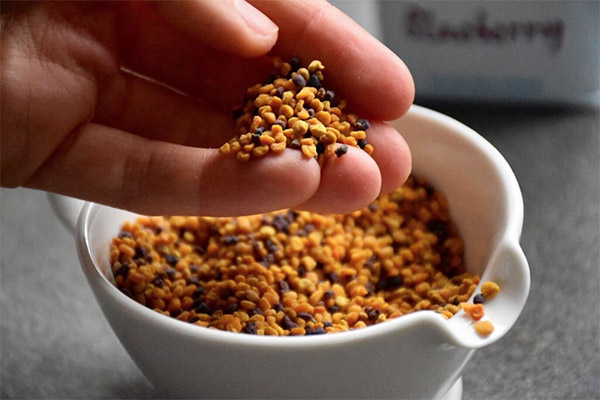
Bee pollen also helps improve prostate health. In some cases, this product is useful during prostate cancer treatment because the antioxidants in pollen inhibit the growth and development of cancer cells. Pollen helps to reduce swelling of the prostate as it has anti-inflammatory properties.
The vital nutrients in pollen - protein, amino acids, carbohydrates, vitamins, minerals and enzymes - help increase the body's energy and stamina. It is worth noting that pollen is very often part of the diet of men who are bodybuilders, as the proteins and amino acids help them build and strengthen their muscles.
When pregnant.
There are different opinions among nutritionists as to whether bee pollen is good for pregnant and nursing women. A lot of controversy has been caused by this topic, because the results of studies are quite ambiguous. Some women who took bee pollen during pregnancy did not feel any side effects, and spoke only about the positive effects, while others experienced some discomfort, and in some cases had to undergo additional examinations for allergies.
The most common fear of pregnant women when taking bee pollen is the effect of the product on the baby. Research proves the fact that consuming the product during pregnancy in moderate amounts can benefit the health of both the mother and her baby.
Here are some useful properties of bee pollen for women in the position:
- Reduces the risk of hypertension. Bee pollen helps purify the blood and supply oxygen to the brain cells. This reduces the risk of high blood pressure and hypertension in women throughout pregnancy. Hypertension can be dangerous for both the mother and the baby in her womb.
- It helps in the development of the baby. The substances in pollen stimulate the development of the brain and nervous system of the fetus.
- Replaces nutrient deficiencies. One of the main benefits of using bee pollen for pregnant women is that it replenishes mineral and vitamin deficiencies.
- It strengthens the immune system. The high level of antioxidants in bee pollen helps to strengthen the immune system of the mother, without affecting the development of the fetus. It also protects pregnant women from colds, flu and other diseases.
For kids
Pollen is good for both adults and children. It can be included in children's diet, but only if the child is not allergic or intolerant to bee products.
The daily dose is usually listed on product labels. Adults are recommended to take 1-3 tablespoons of bee pollen.
- Children aged 3 to 6 years old are given half a teaspoon.
- Aged 6 to 12 years - 1 teaspoon per day.
- Children over 12 years of age - a daily dosage of up to 2 teaspoons.
Important: Before giving pollen to children, check whether the child is allergic to it. If there is even the slightest reaction, you must immediately stop taking it!
How is bee pollen useful for weight loss?
Bee pollen is very useful for people who want to get rid of extra pounds. Here are some reasons why it is recommended to use pollen for weight loss:
- It helps stimulate metabolic processes, which in turn accelerate the burning of calories.
- It acts as an appetite stabilizer and at the same time is a natural energizer.
- It is low calorie, tasty and easy to eat.
- Pollen is rich in lecithin, which helps digestion and metabolism. It lowers LDL levels and raises healthy HDL cholesterol.
Therapeutic properties of bee pollen
Bee pollen has these medicinal properties:
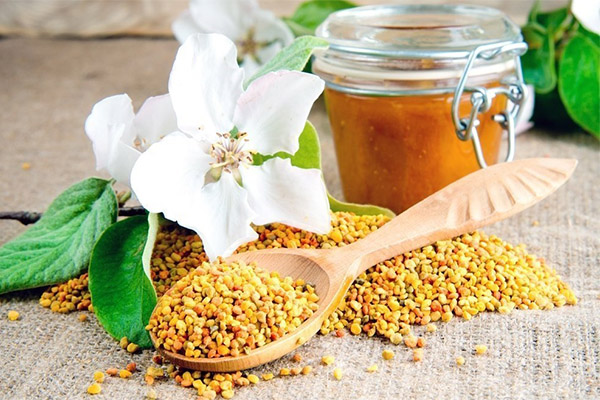
- It helps heal wounds. Because of its antioxidant properties, bee pollen can help fight inflammation caused by burns or injuries of all kinds. It works just as effectively as some anti-burn remedies, has fewer side effects, and actually shortens the time it takes to fully heal. Because bee pollen also fights bacteria and infections, it can help reduce the chance of infection from wounds or burns.
- Relieves seasonal allergies. Bee pollen can be used to control seasonal allergies such as hay fever. Note that bee pollen itself can sometimes cause allergic reactions, so if you are allergic to bees, you should consult your doctor before using bee pollen. If you are not allergic to bee products, then by consuming bee pollen you are increasing your body's resistance to plant allergens that bees can come into contact with, thereby reducing the overall seasonal allergic reaction. This will only be effective if you are using local bee pollen, as you are trying to fight allergies in the area where you live. Bee pollen can also help slow down the activity of mast cells. The inhibition of these cells leads to a reduction in allergy symptoms.
- It fights the development of cancer. Cancer is caused by abnormal cell reproduction, and bee pollen can interfere with this process. Because it can stimulate cell death in tumors, pollen prevents the development and spread of cancer, especially in cases of colorectal and prostate cancer, as well as leukemia. Bee pollen can help reduce systemic inflammation, reduce the risk of infection and counteract the development, growth and spread of tumors.
Bee pollen in cosmetology
Bee pollen has many beneficial properties that can be used in the field of cosmetology.
- It cures acne. Bee pollen contains natural antibiotics that prevent acne.
- Hair benefits. Pollen strengthens the roots, gives the hair a natural shine and prevents hair loss. It can be added to shampoos by dissolving 1 teaspoon of bee pollen in 1 tablespoon of shampoo.
- Supports healthy nails. Consumption of pollen promotes stronger and healthier nails.
- Improves skin appearance. Bee pollen contains carotenoids, flavonoids and phytosterols that promote cell regeneration.
You can also note the benefits of pollen for facial skin. Masks based on it are suitable for any type of skin.
Recipes of facial masks
- For rejuvenation. We will need - 1/2 tsp. pollen, 1 tsp. natural honey, 1 tbsp. mineral water (non-carbonated). The pollen should be well dissolved in warm water, and then put honey in it. After that, you need to thoroughly mix the resulting mixture. The remedy should be applied to the face and massage gently the skin for 4-5 minutes. After 30 minutes, wash your face with warm water.
- From wrinkles. Take 0.5 tsp. of pollen, 1 tsp. of honey and 1 tsp. of store-bought sour cream (20%) and mix the ingredients until homogeneous. Apply the mixture to the skin for 15 minutes.
- To nourish the skin. Take 2 tsp. of pollen, 10g. of beeswax, 10g. of glycerine and 25g. of oil (vegetable). Ingredients should be thoroughly mixed to a homogeneous consistency and applied to the face. The mask should be covered with a napkin and keep for about 7-8 hours, so it is better to do the procedure at night.
How to take bee pollen
Bee pollen can be in capsules, powders, raw pellets, it can be mixed with drinks, salads, various dishes or used as a supplement between meals. The most popular method is to take 1 tablespoon 30 minutes before a meal. It can also be used as a substitute for regular food. To do this, take a few tablespoons of pollen, dissolve it in water and drink it. Since this product causes a burst of energy, it is not recommended to take it before going to bed, it is better to do it in the morning or in the afternoon.
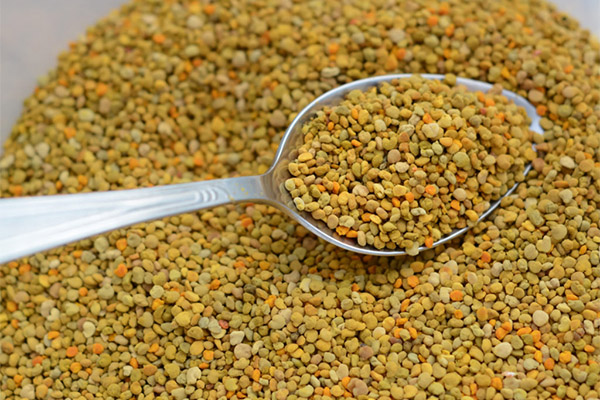
When using it, it is worth adhering to some rules:
- It is not recommended to swallow the pollen immediately. After entering the mouth, you need to chew it well and mix it with your saliva.
- It is necessary to use in 2-3 intakes. The first reception in the morning on an empty stomach, the last - no later than 18:00.
For prophylaxis
Prophylactic course should last about 30 days, it is desirable to conduct a course 3 times a year (at the end of fall, winter and early spring).
Health Hazards and Contraindications
Despite the fact that pollen has many useful properties, it is not recommended for use by people who suffer from allergies, with intolerance to this product, as well as with blood clotting disorders and diabetes. Pregnant and lactating women can use bee pollen, but in small doses and only after consulting your doctor.
How to store bee pollen
Bee pollen should be stored in a dry form. It should be well cured in a drying oven at a temperature of about 40 ° C, and then poured into a tightly closed container (such as a glass jar) and sent to the refrigerator. In this form it can be stored for 22-24 months.
There is an even more interesting method of storing this product. It consists in the fact that the pollen is mixed with honey (in a proportion of 1 to 2) and stored in such a form in a cool place (storage period - up to 5 years).
«Important: All information on the site is provided solely for introductory All information on this site is provided for informational purposes only. Before using any recommendations consult a health care professional. specialist. Neither the editors nor the authors are liable for any possible harm caused by materials."

